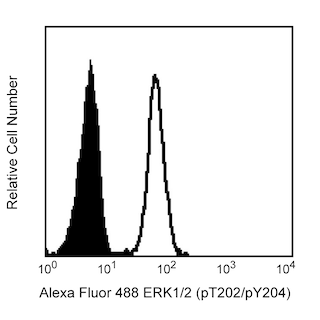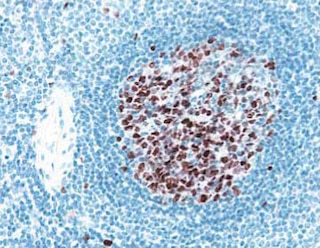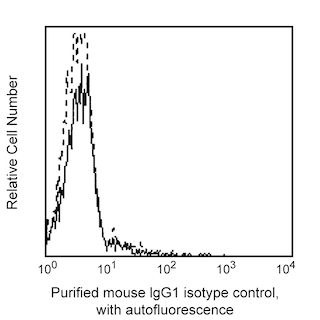Old Browser
This page has been recently translated and is available in French now.
Looks like you're visiting us from {countryName}.
Would you like to stay on the current country site or be switched to your country?




Human STING Expression Panel 1. Western blot analysis of STING expression by THP-1 cells. Proteins from human THP-I (Acute monocytic leukemia, ATCC TIB-202) cell lysates were resolved by SDS-PAGE, blotted, and then probed with 0.25 μg/ml (Lane 1), 0.125 μg/ml (Lane 2), and 0.063 μg/ml (Lane 3) of Purified Mouse Anti-Human STING antibody (Cat. No. 564835) followed by HRP-conjugated Goat Anti-Mouse IgG (Cat. No. 554002), and ECL detection reagents. STING was identified as protein bands of ~35-40 kDa. Panel 2. Flow cytometric analysis of STING expression in human peripheral blood leucocytes. Blood was treated with BD Phosflow™ Lyse/Fix Buffer (Cat. No. 558049) to lyse erythrocytes and fix leucocytes. Cells were permeabilized and stained in BD Perm/Wash™ Buffer (Cat. No. 554723) with either Purified Mouse IgG1, κ Isotype Control (Cat. No. 555746, Upper Plot) or Purified Mouse Anti-Human STING (Lower Plot), followed by staining with PE Goat Anti-Mouse Ig (Cat. No. 550589). Contour plots showing the coexpression of STING (or Ig Isotype control staining) versus side light-scatter characteristics (SSC) were derived from gated events with the forward and side light-scatter characteristics of intact leucocytes. Flow cytometry was performed using a BD FACSCanto™ II Flow Cytometer System. Panel 3. Immunohistochemical staining of STING expression in human tonsils. After antigen retrieval with BD Retrievagen A Buffer (Cat. No. 550524), the formalin-fixed paraffin-embedded tonsil sections were stained with either Purified Mouse IgG1 κ Isotype Control (Left Images) or Purified Mouse Anti-Human STING (Right Images). A three-step staining procedure that employs Biotin Goat Anti-Mouse Immunoglobulin (Cat. No. 550337), Streptavidin-HRP (Cat. No.550946), and the DAB Substrate Kit (Cat. No. 550880) was then used. The Anti-STING antibody stained some lymphocytes and endothelial, epithelial, and dendritic cells. Original magnifications: 20X for Upper and 40X for Lower Images.


BD Pharmingen™ Purified Mouse Anti-Human STING

Regulatory Status Legend
Any use of products other than the permitted use without the express written authorization of Becton, Dickinson and Company is strictly prohibited.
Preparation And Storage
Product Notices
- Since applications vary, each investigator should titrate the reagent to obtain optimal results.
- Please refer to www.bdbiosciences.com/us/s/resources for technical protocols.
- An isotype control should be used at the same concentration as the antibody of interest.
- Caution: Sodium azide yields highly toxic hydrazoic acid under acidic conditions. Dilute azide compounds in running water before discarding to avoid accumulation of potentially explosive deposits in plumbing.
- Sodium azide is a reversible inhibitor of oxidative metabolism; therefore, antibody preparations containing this preservative agent must not be used in cell cultures nor injected into animals. Sodium azide may be removed by washing stained cells or plate-bound antibody or dialyzing soluble antibody in sodium azide-free buffer. Since endotoxin may also affect the results of functional studies, we recommend the NA/LE (No Azide/Low Endotoxin) antibody format, if available, for in vitro and in vivo use.
- Species cross-reactivity detected in product development may not have been confirmed on every format and/or application.
Companion Products






The T3-680 monoclonal antibody specifically recognizes human STING (Stimulator of interferon genes protein) which is also known as Endoplasmic reticulum interferon stimulator (ERIS) and Mediator of IRF3 activation (MITA). STING is encoded by TMEM173 (Transmembrane protein 173). STING is a multi-pass transmembrane adaptor protein which is widely expressed in the endoplasmic reticulum of cells. STING acts as a sensor of cytosolic double-stranded DNA derived from bacteria and viruses and promotes the production of type I interferons, IFN-α and IFN-β. Following activation, STING translocates with TBK1 kinase to perinuclear endosomes. The TBK1 kinase phosphorylates and activates interferon regulatory factors, such as IRF3, and NF-κB, which leads to the induction of type I interferon and other immune response genes that play roles in innate and adaptive immunity.
Development References (5)
-
Ablasser A, Goldeck M, Cavlar T, et al. cGAS produces a 2'-5'-linked cyclic dinucleotide second messenger that activates STING. Nature. 2013; 498(7454):380-384. (Biology). View Reference
-
Ishikawa H, Barber GN. STING is an endoplasmic reticulum adaptor that facilitates innate immune signalling. Nature. 2008; 455(7213):674-678. (Biology). View Reference
-
Sun L, Wu J, Du F, Chen X, Chen ZJ. Cyclic GMP-AMP synthase is a cytosolic DNA sensor that activates the type I interferon pathway. Science. 2012; 339(6121):786-791. (Biology). View Reference
-
Unterholzner L, Keating SE, Baran M, et al. IFI16 is an innate immune sensor for intracellular DNA. Nat Immunol. 2010; 11(11):997-1004. (Biology). View Reference
-
Zhang Z, Yuan B, Bao M, Lu N, Kim T, Liu YJ. The helicase DDX41 senses intracellular DNA mediated by the adaptor STING in dendritic cells. Nat Immunol. 2012; 12(10):959-965. (Biology). View Reference
Please refer to Support Documents for Quality Certificates
Global - Refer to manufacturer's instructions for use and related User Manuals and Technical data sheets before using this products as described
Comparisons, where applicable, are made against older BD Technology, manual methods or are general performance claims. Comparisons are not made against non-BD technologies, unless otherwise noted.
For Research Use Only. Not for use in diagnostic or therapeutic procedures.
Report a Site Issue
This form is intended to help us improve our website experience. For other support, please visit our Contact Us page.